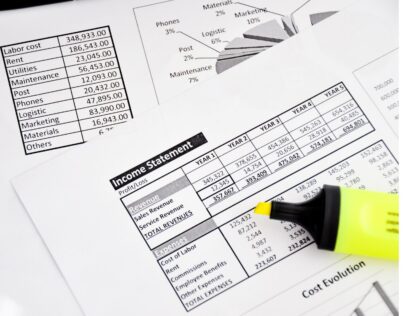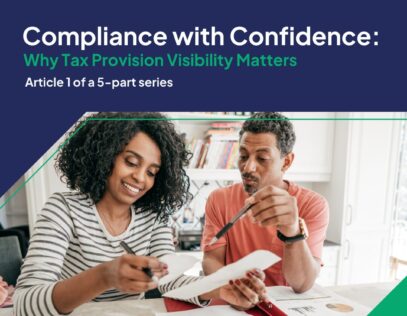Every tax professional knows that one of the most challenging parts of the job comes at the financial year-end: Preparing the annual corporate income tax provision.
Just as finance and accounting executives breathe a sigh of relief from completing—and passing off—those onerous “pre-tax” financial statements, the tax department picks up the torch and races to make sense of those numbers from a tax perspective. It’s a high-pressure situation—requiring a host of complicated calculations performed on a time crunch—and every tax executive who has to do it feels the heat.
Except for those who don’t.
What’s the difference between tax executives who lose sleep over the income tax provision and those who don’t? A few simple tax-professional habits, which can turn a stressful, all-encompassing calculation into a seamless one. Don’t worry. We’re big believers that everyone—even tax managers on deadline—should benefit from good nightly REM cycles, and so we’re revealing those game-changing secrets right here.
Habit #1: Mind your peers’ effective tax rates.
In 2020, California-based video game publisher of hits like Call of Duty and World of Warcraft, Activision Blizzard, Inc., reported an effective tax rate (ETR) of 16%. However, Sony Corporation, one of its main competitors, reported an effective tax rate of 22%.
Nintendo, another competitor, reported an effective tax rate of 28%. Three companies in the same industry spanning an effective tax rate difference of 12%. Is that a problem?
It could be. The effective tax rate is a critical benchmark that indicates how a company is performing from a tax perspective—it also measures the efficiency of the tax function itself, so tax professionals interested in keeping their jobs put a lot of effort into getting it right.
Internally, companies compare their effective tax rates year over year and quarter over quarter to make sure they’re in line with their own business trends—but external comparisons help to measure things, too.
For example, Activision’s CFO might look at Nintendo’s effective tax rate and say, “What is going on? Why is our ETR not moving in lockstep with a key competitor here?” In this case, there is a completely reasonable explanation for the difference—with tax rate differentials between countries of operation (i.e., Japan with a higher statutory tax rate than the U.S.) being the main driver, along with Activision taking advantage of R&D tax credits and other U.S. tax incentives.
But it is important to do that analysis and understand the competitive landscape from a tax perspective. ETRs within the same industry don’t need to be the same, but tax professionals should know their competitors tax posture well and ensure they can explain why their rate may differ than industry norms.
On the flip side, with the highest effective tax rate in the group, Nintendo’s CFO might wonder if the tax function is performing efficiently enough. “Why are we paying a higher effective tax rate than our peers? Are we claiming enough tax credits? Are our businesses located in too-high-tax jurisdictions?” The effective tax rate, whatever it is, may in fact be valid, but tax executives have to know why it is what it is.
Understanding not only your ETR, but also that of your industry peers helps to provide benchmarks to measure against and may highlight areas of tax efficiency or inefficiency. If your effective tax rate is significantly higher or lower than competitors, then auditors and regulators—not to mention, shareholders and members of the
C-suite—are likely to wonder what’s driving the difference.
Is it prudent, advanced tax planning that is driving the rate down? Or a lack of tax planning causing the company to potentially pay more tax than it has to? Are you properly valuing your deferred assets? Taking advantage of R&D tax credits and other tax incentives? Have the proper entity structure and transfer pricing in place? Whatever the case, you’d need to explain that as a tax department and as a company.
The bottom line? Knowing where you stand with industry peers helps tax departments identify what is going well—and what may be going poorly—and provides key insights into not just the tax function, but the business itself.
As for Activision Blizzard, the company lowered its effective tax rate through tax credits, deductions, and by legally operating in lower-taxed jurisdictions. On the other hand, Sony and Nintendo had a different fact pattern based on the businesses’ structures and operations, which makes sense—once you are able to explain it.
Habit #2: Understand accounting rules and tax rules in detail.
One of the provision’s more obvious challenges is that it straddles two sets of rules: accounting rules and tax rules. As a tax executive who wants to show the C-suite and investors an accurate tax position, it’s up to you to reconcile both sets.
Your pre-tax “book” income is your starting point, and that of course, stems from the world of accounting, determined by following Generally Accepted Accounting Principles (GAAP).
That amount then gets funneled into the world of tax, where you make applicable adjustments—or permanent and temporary book-to-tax differences—to get to your taxable income. Unlike accounting laws, tax laws are based, in the U.S. at least, around the Internal Revenue Code (IRC), not GAAP.
So, once you’ve calculated your taxable income, under the IRC rules, you can then apply a tax rate, and layer in any tax credits, to get to your current provision, or current tax expense.
This amount, paired with the deferred tax expense/benefit, will be the income tax expense that ends up in the financial statements—which should be reflected under the accounting standards applicable to tax provisions (guidance under GAAP known as ASC 740). So, really when we said the tax provision straddles two sets of rules, we were wrong: The provision not only straddles them, but it requires you to jump back and forth between them.
The exercise is a headache for sure, not just because there are two sets of rules—but because these rules have opposing goals. Tax authorities want to speed up income and slow down expenses, so the government gets more tax revenue. Accounting regulators, however, want to slow down income and speed up expenses, to have companies report more conservative earnings to the public and not overstate income.
Accounting rules work under the accrual method, meaning expenses are recorded when they’re incurred. Same goes for revenue—you record it when it’s earned. Accounting isn’t about cash hitting the company bank account, it’s about matching up expenses and income when activities take place—when income is earned or when services, leading to an expense, are rendered.
On the other hand, the baseline for tax treatment (of course, with a whole slew of exceptions) is the cash method—not the accrual method. When cash comes in the door—it hits your bank account—you recognize income. And when cash goes out the door—it’s no longer in your account—you recognize expense.
But it’s not quite that easy—partially because of all of those exceptions—which is why it’s important to understand the nuances within the rules. Business transactions can be complicated situations and a close understanding of the accounting and tax rules can prevent a company from making costly errors, along with helping to save tax dollars.
Let’s say, for example, a calendar-year company has a good year in 2022 and announces it’s going to give employees bonuses (hooray!), but it’s not going to pay those bonuses until after the 2022 year-end, in the first quarter of 2023.
The question becomes, how and when does that expense get recorded on financial statements? In 2022? Or, 2023? Under accounting rules, the expense would be recorded in 2022, because that’s when the expense was incurred. Under tax rules, however, the expense is recorded when cash is spent, so the bonuses would hit the financial statements in 2023 when employees actually receive the payouts.
But of course, in the tax world, it’s never that simple (read: slew of exceptions)—tax rules offer an exception where if the bonus is “fixed and determinable” at year-
end, and the company pays the bonus expense within two and half months after its financial year-end, it can deduct that expense in the prior year, which depending on what’s happening at the company, could be an opportunity to lower your taxable income and reduce cash tax expense. But you can only take advantage of opportunities like that if you really understand the rules.
Habit #3: Update your provision model in real time every quarter.
An average tax department runs a tax provision with historical information, only when required. An average public company’s tax department may run a provision on a quarterly basis, as required, but they often don’t pick up this calculation in between those quarterly calculations. Even more alarming, an average private company’s tax department, potentially without the regulatory requirements to produce a quarterly calculation, may only run a provision once a year.
The issue with these average tax departments is simple—they are living in the past, working with historical data that is already “old and cold.” If you’re working only with historical data, you can’t work with finance, accounting, and the overall business to strategize for tomorrow.
The best tax departments live in the future. Yes, you need to work with historical data to run the required quarterly or annual provision computations, but you should be in constant communication with finance, accounting, and other business departments during the entire year.
The best tax departments have a seat at the table for business decisions and provide the prospective tax implications to managers executing those decisions. Maybe that’s creating a forecasted provision model to estimate the impact of future items or updating the provision model as the quarter progresses to show management the real-time impact of their decisions.
If you want to make your tax department a true value-add part of the business, you have to move in lockstep with the overall business—and the provision is the sandbox where this happens. As for those average tax departments, they’re just playing catch up.
Habit #4: Embrace technology.
Research shows that roughly 80% of U.S. corporations calculate the income tax provision in Excel. That means roughly 80% of U.S. corporations are vulnerable to broken links, circular reference errors, and the burden of manual data entry, not to mention, the annoyance that comes with shifting between workbooks.
While those issues are frustrating, the bigger problem is that constructing your tax provision manually makes your calculations prone to error—and your company susceptible to financial misstatements or even restatements.
Fortunately, tax software can transform the provision process, making it easier to pull numbers, catch errors, and meet tight deadlines. In fact, many tax executives already know they need to get out of an Excel environment—and auditors and CFOs are prodding them to do so to save time, money, and resources.
Another advantage? Tax software connects you to the numbers—and therefore, the business. Some tax executives have a hard time believing that, but it’s true. They think it’s the manual entry that keeps them engaged with the story the financials are telling and that automation eliminates that in-depth understanding.
Wrong. Software actually brings you closer to the financials because it lets you interact with the numbers:
You can track data and trace amounts back to their original sources. (Convenient for when auditors ask where a calculation originated.) You can trust the calculations, analyze your data, and even test different scenarios to see various potential outcomes, which maximizes your tax function’s efficiency, puts your company in a better tax position, and allows the tax department to add value to the business.
Habit #5. Keep an eye on the future.
You may be preparing the annual tax provision to reflect the taxes you pay in one year, but let’s face it: The tax provision is about the past, present, and the future. So, to strategize a company’s tax position, you want to stay abreast of legislation that could impact tax laws and accounting regulations before it takes effect.
New income-tax laws, obviously, have a direct impact on the tax provision— for instance, a change to the tax rate would have a direct impact on provision calculations and the effective tax rate.
And income-tax laws are changing all the time in countries all over the world. Consider the OECD’s global minimum tax proposal, which may go into effect in the EU as soon as next year.
If a tax executive is paying attention, there could be new opportunities to reduce a company’s effective tax rate or cash tax based on this pending legislation. If a tax rate is going up and you’re planning for it, you could defer expenses to future years where you’ll get a more valuable tax deduction. You could also accelerate income to the current year when it will be taxed at a lower rate, which could mean a permanent tax savings.
And let’s not forget about deferred tax assets and liabilities, which come into play in both the present and the future. If a new tax rate is coming, you want to examine those deferreds and figure out how they should be properly valued. Should you revalue deferreds at a different rate?
If laws are changing, how do those new laws impact the future taxability or deductibility of certain items? Back to that enacted versus effective analysis, where an enacted rate change or law change would be enough for the deferreds to have to reflect the change.
The deferred roll forward is a continuum that looks forward not just into the current year, but through the whole life of the company. So, as you have these ending assets and liabilities, you want to make sure they’re valued appropriately and paying attention to changes in the tax law—and maybe embracing a few game-changing tax professional habits—can help you do that.







